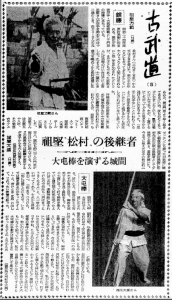Kobudō 5: Soken Hōhan and Shiroma Taisei
[Okinawa Times] November 22, 1961
Kobudō 5
Soken, the successor of “Matsumura”
Soken Hōhan (70)
Kusarigama
He was born in 1891 in Gaja, Nishihara Village. Presently, he teaches students as an instructor of Shōrin-ryū (1) karate and kobujutsu.
Mr. Soken started karate when he was 12 years old. He was initiated by his mother Kamī’s elder brother, Mr. Matsumura (3rd generation of Shuri) (2).
He explains that although having reached a certain age, if a boy keep loafing, he won’t become a man which is why he was introduced to karate. But for the boy that Soken was still, it seems that training at that time was extremely strenuous. At 20 of age, leaving his parents’ home, he started living at the Matsumura Dōjō. He recalls that he would wake up before others students and undergo morning training, while training occurred also until late in the evening. At the beginning, training was light, but as his level improved, he event underwent training like the way to remove one’s geta clogs and escape. He explains that as the maxim “Karate ni sente nashi” tells, people who train in karate should also research “how to escape in any situation”.
In 1924, a martial art demonstration gathering martial artists from the entire island was held at the Taishō Theater in Naha. Mr. Soken performed next to Kyan Chōtoku, (Chanmī-gwā), Motobu Chōyū (Motobu Sārū) (3) and others.
Mr. Soken has 58 years of martial art experience. During these years, although he has crossed over to Miyako and Argentina, he has kept practicing diligently martial arts. Returning to his home town after WWII, he, as an orthodox (4) successor of Matsumura sensei took the name Shōrin-ryū and opened a dōjō in Gaja, Nishihara Village.
Since then, he has taught almost 200 students and still today, some 20 disciples train hard daily. During the coming demonstration, he will performed Kusarigama while 6 other students will also demonstrate on stage.
(Resides in Gaja, Nishihara Village)
Notes:
- Written Sukunai Hayashi
- Most likely the master known as Nabī Tanmē. According to the “Okinawa Karate Kobudo Encyclopedia”, a theory is that he was Tomimura Pēchin, one of the demonstrators during the last Ryukyuan reception for Sapposhi.
- While Motobu Sārū is the nickname of Motobu Chōki, in the original text it is written after Motobu Chōyū, the eldest son of the Motobu family.
- Seitō in Japanese can be translated in orthodox, legitimate and traditional.
- Master Soken passed away in 1982.
Shiroma demonstrating Ufutun Bō
Shiroma Taisei (77)
Ufutun Bō
He was born in 1885 in Ōzato Village Aza Ōshiro. At a young age, he became interested by watching the soul-stirringly Bōjutsu performances of the youth of the hamlet during festivals.
At the age of 17, he started practicing by visiting the house of Futenma Ōfu (1) sensei who was teaching Bōjutsu in the village. As he was gifted for athletics, his teacher told him “No mistake you will become skillful” and thus he was taken care of more than others. From then on, he kept practicing until 2-3 years after the end of the war. Remembering his young years, speaking with an impatient expression, he tells “No one can’t win over age, only now am I able to swing the staff…”
In 1928, he performed during the imperial commemorative demonstration for the present emperor that was held at Yonabaru Elementary School. His demonstration on that day is his most cherished memory.
“I would like for the youth of the hamlet to temper their body by learning Bōjustu, but the youngsters of today ignore the bō. Yet, this is a physical activity that one can have fun alone with at any time, and that is perfectly suitable within the countryside. If through the coming demonstration, some youth of the villages understand, even if young I will teach them. Now I am troubled as there is nobody. Even myself, only now am I confident on being capable of performing correctly at least the moves of Ufutun Bō.” So speaks humbly Shiroma.
He has been teaching his first son Seikō since a young age, and although he has learned Ufutun Bō, he presently lives in Sawatsu City in Shizuoka Prefecture. Because he was my son, he accepted my selfishness and whim; on moonlight nights, I more than once woke him up during the night and taught him on the hill.
He goes on saying “With the coming soon Kobudō demonstration, having notified him by letter that I was going to perform Ufutun Bō, my son was happy telling me to be careful but also encouraging me to do my best.” Then, grabbing the Bo that was placed in the Tokonoma alcove, he said “This is Ufutun Bō” and went on to perform the kata.
(Resides in Aza Oshiro, Ozato Village)
(1) The name’s reading is unclear.

